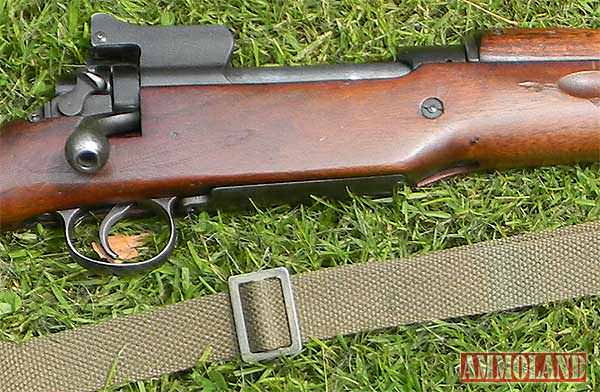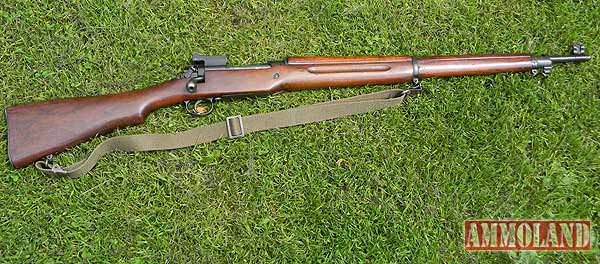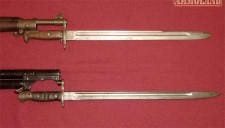By Marc Cammack


Bangor, Maine – -(Ammoland.com)- The First World War was largely a war fought with bolt action magazine rifles.
When the US Army arrived to the fight in 1917 they discovered that there were only about 600,000 1903 Springfield rifles available.
This was not enough to equip the large American Expeditionary Force fighting in France.
A new rifle would be needed to fill the need and the rifle would be produced in the United States, but designed in England. This rifle would be based on a British design and it would be called the M1917 Enfield.

M1917 Enfield Rifle
Remington, Winchester, and Eddystone had produced a rifle called the Pattern 14 (Read British P-14 Rifle in .303 British – The Other British Enfield ) in .303 British to supplement their Lee Enfield rifle production. The Pattern 14 was a 5 shot rifle using a modified Mauser action that cocked on closing. The Pattern 14 would be produced mostly in 1916 and would see service as a sniper rifle and as a reserve weapon by the British Empire during the First World War.
The Pattern 14 would be modified to suit the American Army’s needs and to equip troops going overseas. The resulting rifle was called the M1917 Enfield. The first change was the caliber which was redesigned for the American 30-06, another was the elimination of the volley sight on the left side of the stock. The same companies that produced the Pattern 14 would produce the 1917 Enfield. Eddystone would produce the most of the 1917 rifles, followed by Remington and then Winchester which produced the least amount of rifles.
The 1903 Springfield is lighter than the 1917 Enfield. Also the 1917 Enfield’s rear sight is not adjustable for windage. However the peep sight of the 1917 Enfield was much quicker to use in combat than the open sights of the 1903 Springfield. When 1917 Enfields were released for sale to the public many were converted to big calibers such as the .375 H&H magnum round. Also Remington would build a sporting rifle called the Model 30 based on the M1917’s action.

One interesting prototype version of the 1917 Enfield was a semi automatic conversion designed by John Pedersen. This conversion was known as the Pedersen Device and converted the 1917 to the French 7.65x20mm Longue cartridge. Pedersen had designed a similar conversion for the 1903 Springfield and on the 1903 the conversion was made in much greater numbers and at least one Remington Mosin Nagant was converted.
The 1917 Enfield would have a blade type bayonet designated the M1917 bayonet. The M1917 bayonet was very similar to the British Pattern 1917 bayonet. These bayonets would be made by Winchester, and Remington. They would also be fitted to many of the American Trench shotguns such as the famous 1897 Winchester Trench gun.
The 1917 Enfield would have quite the combat history seeing action in both World Wars. The rifle is said to have made up 2/3s or more of the rifles used by the American Expeditionary Force during the First World War. The weapon would prove itself rugged in reliable in the Meuse Argonne Offensive of 1918. The famous Sergeant Alvin York is widely believed to have used a 1917 Enfield in the action that won him the Medal of Honor in 1918.

The Second World War would see the M1917 Enfield at war once again. The M1917 would be used in the Bataan Campaign both by Filipino and American troops. The rifle would also see service as a secondary rifle in the early part of the war. During the Japanese invasion of the Aleutian Islands in 1942, Alaskan Native Scouts would use the 1917 Enfield to repel the invasion.
During the Second World War many of the rifles would be rebarreled and refurbished. Johnson Automatics who had produced the M1941 Johnson Rifle, along with High Standard would produce barrels for the 1917 during the Second World War. Some of these rifles would be inspected by the famous gun writer Elmer Keith at the Ogden Arsenal in Utah.
The 1917 would be widely used by other nations during the Second World War. The British Home Guard used the rifle alongside their Pattern 14s. Many Nationalist Chinese Troops would use the weapon to fight the Japanese. Some 1917’s were shortened by 5 inches for the Chinese X Force, which assisted the British in Burma. Finally some Free French troops were also equipped with the 1917 rifle in their fight against the Nazis.
The rifle is still in use in by the Danish Sirius Sled Patrol alongside the Glock 20, due to the 1917’s reliability and the power of its cartridge. In the United States the 1917 Enfield is still available on the secondary market.
They do not bring the same kind of money that a 1903 Springfield or M1 Garand do, but still have an extensive combat history. They can be found through private sales or at small gun shops throughout the country.

About Marc Cammack
Marc Cammack has been collecting firearms since he was 14 years old.
His interests are primarily military surplus firearms of the late 19th into the 1950’s. He has studied these in depth, and currently volunteers at two local museums providing them with accurate information about their firearms.
He is a graduate of the University of Maine with a bachelor’s degree in history. He has studied modern European and American history since the age of 9, and has been shooting since the age of 11. He currently resides just outside of Bangor, Maine.

I have a Remington with a Monte Carlo stock and a Parker Hale 7.62 mm/308″ conversion and quality Vernier sights.
Once sighted in it groups tightly at 800 yards with a 155 grain head. Super slick action, low recoil 100 years old next year. These are seriously accurate rifles. Will shoot out to 1200yds on the Stickledown range at Bisley England but won’t group. Lovely rifles, a well designed rifle.
It never fails someone talks about rifles and someone like you comments(it groups tightly at 800 yards with a155 grain head? What is a head? Do you mean a bullet?As far as you grouping at 800 yards yeah right! You are one of those blow hards that could not hit a barn if you were inside of it ! WANKER!
Excellent, informative article. I would like to read more from this author. Thank you!
I am looking for an original 1917 eddystone gun stock
Does any know where I can obtain one?
I have a Eddtstone, I believe a sportmens rifle with scope. 703380. On end of stockR KURN
I have a enfield 06 best damn deer rifle I have still hold a quarter pattern at 150 yards not bad for a rifle that’s almos 100 years old my dad traded my uncle a German Luger for it back in the 50s to hunt with love to have the Luger but can’t complain only thing I got from my dad